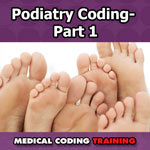I have never used a “cheat sheet” when coding for a particular specialty but podiatry coding changed all that. There are lots of rules — and more rules. There are layers of modifiers when medical coding for foot care that must be sequenced correctly. (If you haven’t accessed the www. webinar on modifiers, this would be the time.) And there are insurance rules. Lots of them.
If you are unfamiliar with Medicare’s Local and National Coverage Determinations, visit their website at http://cms.hhs.gov/mcd and get comfortable within the site. Medicare even provides a Podiatry Manual for reference. Your other alternative would be to subscribe to a website such as www.findacode.com or www.supercoder.com. These coding websites offer you everything a coder needs such as coding descriptions, accepted modifiers for a particular procedure, global periods, fees, RVUs (Relative Value Units) and more. For specific podiatry coding and billing information, there is a website available called www.codingline.com that provides ongoing advice and allows the subscriber to present a question and receive accurate feedback from podiatrists.
Getting Started With Podiatry Coding Modifiers
So let’s begin with modifiers Q7, Q8, and Q9 for routine foot care.
While Medicare generally excludes routine foot care, there are exceptions to the rule:
1. A patient has a systemic disease that results in severe circulatory problems or desensitation in the legs or feet
2. Treatment of warts
3. Treatment of ulcers, wounds or infections
4. Treatment of mycotic nails (fungus) with indications of a Class A (Q7)), Class B (Q8) or Class C (Q9) or presence of a qualifying systemic condition such as metabolic, neurologic or peripheral vascular disease.
To apply a Class Finding, the following findings are necessary:
Q7 – Class A Finding (1 required): Non-traumatic amputation of the foot or integral skeleton portion.
Q8 – Class B Findings (2 required): (1) Absent posterior tibial pulse (2) Absent dorsalis pedis pulse (3) Advanced trophic changes where three of the following are required: hair growth (absence or decrease), nail changes such as thickening, pigmentary changes, skin texture (thin, shiny) and skin color (rubor or redness)
Q9 – Class C Findings (1 Class B and 2 Class C required): Claudication, Edema, Paresthesia, Temperature Changes and Burning
Coders need to present diagnosis codes and a class finding (if applicable) that will aid the biller in applying pertinent information to the claim form should documentation indicate it. For example, if documentation points to ICD-9-CM code 250.70 – Diabetes Mellitus with Peripheral Circulatory Disorder, Unspecified with manifestation code 785.4 – Gangrene, the biller will enter in block 19 of the CMS-1500 form, the date the patient was last seen by the doctor currently treating the systemic condition (every 60 days) and the physician’s NPI. She will need to know the global period of a procedure in the event the patient has to be seen for other issues on another day, which often happens in podiatry.
If multiple surgical procedures are performed, remember to use payable modifiers before class finding Q modifiers, or the ten digit toe modifiers (TA-T9), or the left or right foot modifier (LT, RT). There are a lot of precise rules to coding and billing Podiatry.
Coming soon: PART 2: Podiatry- Routine Foot Care Exclusions, CPT/HCPCS Codes and DME
![[CCO] Certification Coaching Organization LLC [CCO] Certification Coaching Organization LLC](https://www.cco.us/wp-content/uploads/2015/05/CCO-Logo-2015-d3-500px.png)

I just started working as a medical biller for a Podiatrist i did not know how much coding was involved looking to take a class asap.
Saw the above message and I’m in the same situation. Just accepted podiatrist as new client, have not billed for that specialty before. Do you offer online classes? Other resources?
Thank you,
Lyn
I have been working for a DPM and my coworker is NOT interested in assisting me in this different type of doctor’s office setting as for billing. I am in need of help in using modifiers, how soon I may schedule a Medicare patient, and with your office services codes. I would prefer to do this online. HELP
There have been so many problems with podiatry and some Medicare contractors (NGS being a big problem) not updating their LCDs since ICD-10-CM so handling anything prior to 2016 will be labor intensive. What I strongly suggest is going to the Medicare website and looking for the regulations for podiatry. There are 3 groupings of codes that focus on routine foot care. Some require the Q7, Q8, and Q9 and only one particular set of medical necessity codes plus date last seen (approximately every 60 days and name of supervising provider-(not DPM name)
Initial visits and re-evaluations can be linked to procedure(s) with modifier 25. Any surgical procedures-be sure you know if they are 0-10- or 90 day global. If a procedure is a 10 day global and the doctor sees the patient again, make sure it is on the 11th day, Use ABNs of needed. Rules are very specific. Not too many to remember but you have to follow the rules precisely. Use your modifiers 59.51, 78 and 58 a lot if applicable in addition to the qualifiers Q7,8,9. Routine foot care codes 11056, 11719, as example, follow the 60 day rule. If you do a non-routine foot care procedure, follow surgical guidelines-not the 60 day rule. Medical necessity diagnosis codes are strictly enforced and must be linked to proper procedures. Medicare will present those codes to you.
Trust me. Medicare’s guidelines are excellent/ Just go to your local carrier. They have their own LCDs.